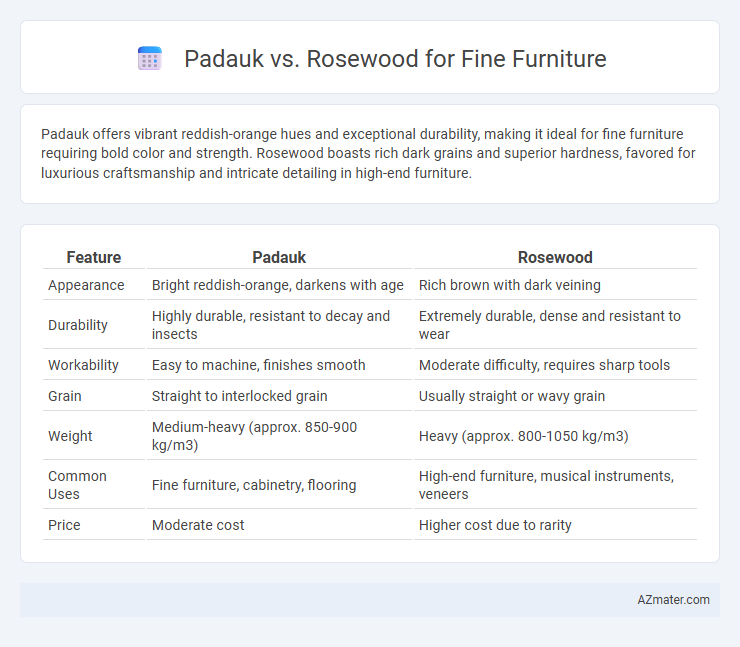Padauk offers vibrant reddish-orange hues and exceptional durability, making it ideal for fine furniture requiring bold color and strength. Rosewood boasts rich dark grains and superior hardness, favored for luxurious craftsmanship and intricate detailing in high-end furniture.
Table of Comparison
| Feature | Padauk | Rosewood |
|---|---|---|
| Appearance | Bright reddish-orange, darkens with age | Rich brown with dark veining |
| Durability | Highly durable, resistant to decay and insects | Extremely durable, dense and resistant to wear |
| Workability | Easy to machine, finishes smooth | Moderate difficulty, requires sharp tools |
| Grain | Straight to interlocked grain | Usually straight or wavy grain |
| Weight | Medium-heavy (approx. 850-900 kg/m3) | Heavy (approx. 800-1050 kg/m3) |
| Common Uses | Fine furniture, cabinetry, flooring | High-end furniture, musical instruments, veneers |
| Price | Moderate cost | Higher cost due to rarity |
Introduction: Comparing Padauk and Rosewood
Padauk and Rosewood are prized hardwoods in fine furniture making, known for their durability and rich hues. Padauk features a vibrant reddish-orange color that deepens over time, while Rosewood is admired for its deep brown or purplish tones with distinctive grain patterns. Both woods offer unique aesthetic and structural qualities, making them popular choices for high-end furniture pieces.
Botanical Origins and Species Overview
Padauk, primarily derived from the Pterocarpus genus, notably Pterocarpus soyauxii (African Padauk) and Pterocarpus indicus (Asian Padauk), is renowned for its vibrant reddish-orange hues that deepen with age. Rosewood refers broadly to several species within the Dalbergia genus, such as Dalbergia nigra (Brazilian Rosewood) and Dalbergia latifolia (Indian Rosewood), prized for their deep, rich brown tones with darker veining and robust durability. Both genera belong to the Fabaceae family, but Padauk woods tend to be more vibrant and lighter, whereas Rosewood offers darker, more textured grains favored in fine, high-end furniture craftsmanship.
Appearance: Color, Grain, and Figure
Padauk wood features a vibrant reddish-orange hue that deepens with age, while rosewood offers a rich, dark brown to purplish coloration often accented by darker veining. The grain of padauk is typically straight or interlocked with a coarse texture, contrasted by rosewood's more varied grain patterns ranging from straight to wavy or curly, providing a glossy, luxurious figure. Both woods display striking visual appeal, but padauk's bright, warm tones stand out against rosewood's classic, elegant depth and complex grain character.
Workability and Machinability
Padauk offers excellent workability with its straight grain and medium texture, allowing smooth cutting and shaping for fine furniture pieces. Rosewood, though harder and denser, provides superior machinability when sharp tools are used, enabling detailed carvings and intricate designs. Both woods respond well to sanding and finishing, but Padauk tends to be easier to glue and less prone to dulling tools compared to rosewood.
Durability and Resistance Qualities
Padauk offers exceptional durability with a Janka hardness rating of around 1720, making it highly resistant to wear and impact, ideal for fine furniture that endures daily use. Rosewood, known for its natural oils and dense grain, provides excellent resistance to moisture, decay, and insect damage, ensuring long-lasting structural integrity in high-end cabinetry and ornamental pieces. Both woods exhibit superior strength and resilience, but Padauk's vibrant color and stability under stress make it a prime choice for durable, visually striking furniture.
Sound and Acoustic Properties
Padauk offers a warm, resonant tone with excellent sustain, making it ideal for furniture that benefits from sound amplification. Rosewood is prized for its rich, complex overtones and superior projection, often used in high-end acoustic instruments and furniture with intricate sound qualities. Both woods provide strong acoustic properties, but Rosewood's dense grain enhances clarity while Padauk's porosity adds a softer, mellower resonance.
Availability and Sustainability
Padauk offers greater availability due to its fast growth and widespread cultivation in tropical regions, making it a more sustainable option for fine furniture production. Rosewood, though prized for its rich color and grain, faces significant sustainability challenges caused by overharvesting and strict trade regulations under CITES. Choosing Padauk supports eco-conscious furniture makers seeking a reliable supply without contributing to deforestation or illegal logging.
Cost and Value Considerations
Padauk offers a vibrant reddish hue and is typically more affordable than Rosewood, making it a popular choice for budget-conscious fine furniture makers. Rosewood, prized for its rich color variations and exceptional durability, commands a higher price due to its rarity and demand in luxury furniture markets. When prioritizing long-term value, Rosewood's superior hardness and aesthetic appeal often result in higher resale value and timeless elegance compared to Padauk.
Popular Applications in Fine Furniture
Padauk is preferred for fine furniture due to its striking orange-red hues and durability, making it ideal for decorative veneers, inlays, and ornamental pieces that enhance visual appeal. Rosewood, valued for its rich dark tones and natural luster, is commonly used in high-end cabinetry, musical instruments, and luxury furniture, prized for both aesthetics and strength. Both woods excel in crafting distinctive, long-lasting furniture, with Padauk favored for vibrant designs and Rosewood for elegant, classic finishes.
Choosing the Best Wood: Padauk or Rosewood
Padauk offers vibrant orange-red hues and exceptional durability, making it ideal for fine furniture requiring bold aesthetics and long-lasting performance. Rosewood provides rich, dark grains and a smooth finish with natural oils that resist moisture, perfect for elegant, high-end pieces with a luxurious feel. Selecting between Padauk and Rosewood depends on the desired color palette, grain pattern, and furniture function, balancing visual impact with durability.

Infographic: Padauk vs Rosewood for Fine Furniture
 azmater.com
azmater.com